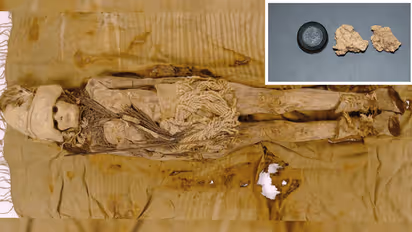Vintage enough? World's oldest cheese found on 3,600-year-old mummies in China, scientists extract DNA

Synopsis
In an astonishing discovery, the archaeologists found the oldest cheese spread over the heads and necks of several mummies unearthed in China.
A well-aged vintage cheddar may be the pride of any respectable cheeseboard, but even the finest varieties pale in comparison to the astounding discovery of the world's oldest cheese, which dates back an astonishing 3,600 years.
First unearthed in 2014 alongside mummified remains in China’s Tarim Basin, this ancient treasure has recently revealed its secrets to scientists. By extracting DNA from the remarkably preserved cheese, researchers have uncovered its key ingredients, shedding light on a centuries-old dietary mystery.
Their groundbreaking analysis has shown that this cheese was made from kefir, a fermented milk drink now lauded for its impressive gut health benefits.
Nearly two decades ago, archaeologists working in the remote Xiaohe cemetery of Northwestern China stumbled upon strange white substances coating the heads and necks of several Bronze Age mummies, which were dated between 3,300 and 3,600 years ago. At first, these substances were suspected to be a type of fermented dairy product, though the precise nature remained elusive—until now.
Thanks to advanced DNA technology, researchers have definitively identified the enigmatic white matter as kefir cheese, made from the milk of cows and goats. The samples taken from three separate tombs contained traces of bacteria and fungi such as Lactobacillus kefiranofaciens and Pichia kudriavzevii, both organisms still commonly found in the kefir grains of today.
Kefir grains are clusters of microorganisms, teeming with probiotic bacteria and yeast, that ferment milk into kefir cheese—a food renowned for boosting gut bacteria, promoting bone health, reducing blood sugar, and improving heart health.
“This is the oldest known cheese sample ever discovered in the world,” said Professor Qiaomei Fu, head of the ancient DNA lab at the Chinese Academy of Sciences. “Food items like cheese are extremely difficult to preserve over thousands of years, making this a rare and valuable opportunity.”
The preservation of the bacterial genes within the ancient kefir cheese not only provides a glimpse into Bronze Age culinary practices but also offers a rare look at the evolution of probiotic bacteria over millennia. Surprisingly, this research challenges the long-held belief that kefir originated solely in the North Caucasus region of Russia, suggesting instead that Northwestern China's Xinjiang region had maintained kefir culture since the Bronze Age.
One of the study's intriguing revelations is that the ancient kefir bacteria, when compared with modern strains, were more likely to trigger an immune response in the human gut. This discovery indicates that today’s kefir varieties have become more digestible over time.
“This is an unprecedented study, allowing us to observe how a bacterium evolved over the past 3,000 years,” Professor Fu added. “By examining ancient dairy products, we've gained a clearer picture of ancient human life and their relationship with their environment.”
In today’s world, kefir has evolved beyond its ancient roots to include products like drinks, yoghurts, and even ice creams—continuing a tradition that dates back thousands of years.
Check the Breaking News Today and Latest News from across India and around the world. Stay updated with the latest World News and global developments from politics to economy and current affairs. Get in-depth coverage of China News, Europe News, Pakistan News, and South Asia News, along with top headlines from the UK and US. Follow expert analysis, international trends, and breaking updates from around the globe. Download the Asianet News Official App from the Android Play Store and iPhone App Store for accurate and timely news updates anytime, anywhere.